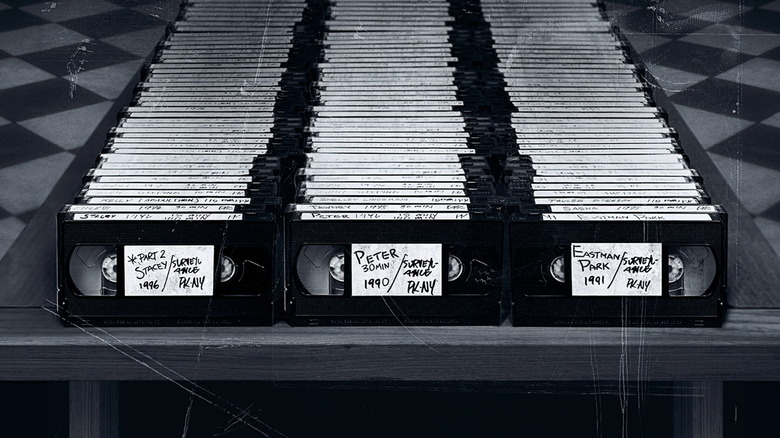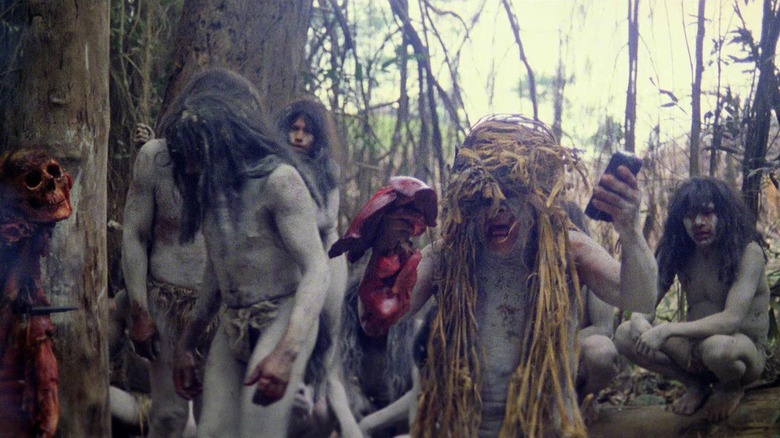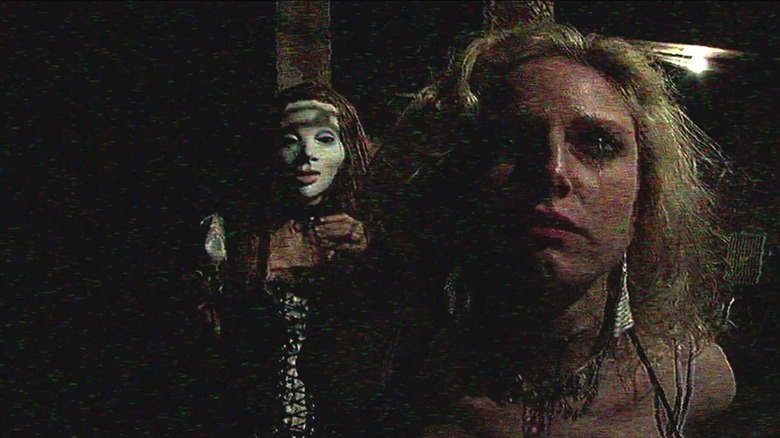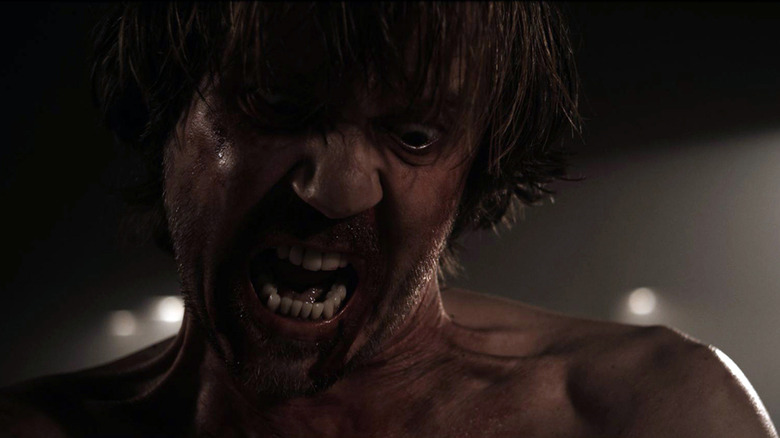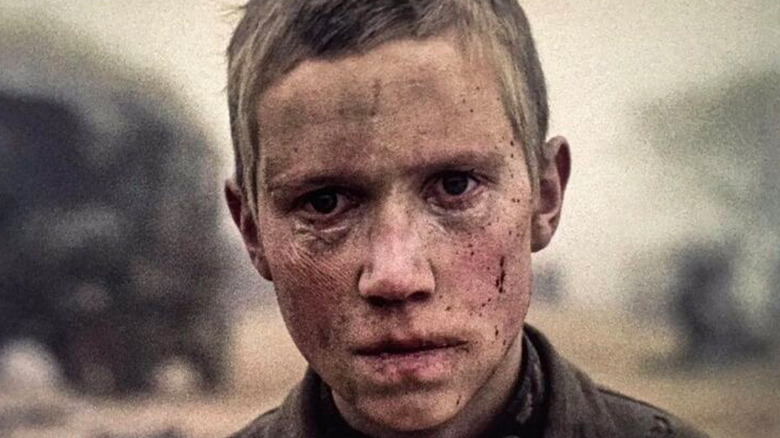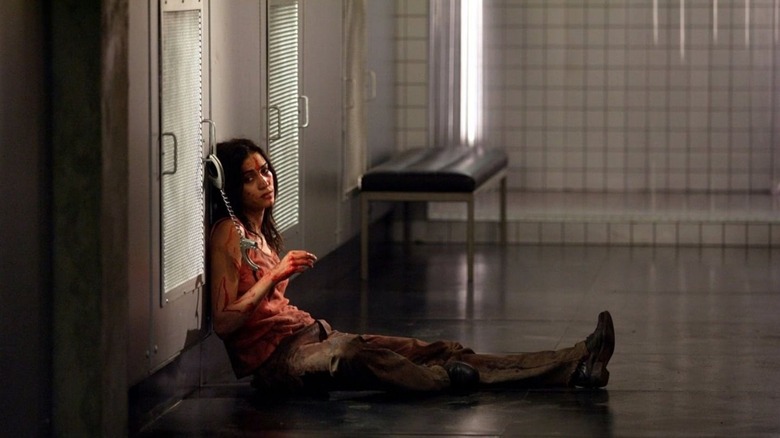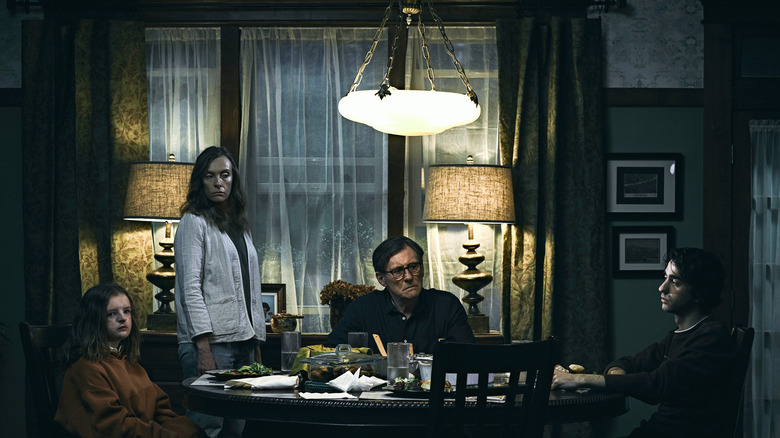Horror Movies That Even Horror Fans Could Hardly Finish
Horror buffs often lean on a dual-edged sword. We're constantly seeking scares that defy anything we've previously seen, but we then tend to experience an unintentional desensitization in the process. If you currently find yourself in a horror rut, the following films practically guarantee nightmares and nausea-inducing gore. Running the gamut from possession tales to psycho killers to cannibalism, there are plenty of boundary-pushing scares (and nasty taboo indulgence) here to make you once again feel that coveted sensation of fear deep in the pit of your stomach.
A word of warning: these movies don't pull any punches. We're going to talk about some dark stuff here.
Cannibal Holocaust
Arguably the OG found footage film, "Cannibal Holocaust" is the litmus test for what true horror aficionados are able to tolerate in terms of torture and gore. Directed by Italian filmmaker Ruggero Deodato and released in 1980, the film follows an NYU professor who ventures into the Amazon to locate a documentary crew that's gone missing on a shoot. What were they filming, you ask? Oh, just your standard vérité doc on local cannibal tribes — the footage of which is the only thing left of the doomed filmmakers.
Filmed in the Amazonian jungles of Colombia and featuring real-life Indigenous residents as the brutish cannibals, the film's legacy certainly carries the weight of a characterization that is totally exploitative and loaded with racism. It also features visceral animal torture — turtles, squirrel monkeys, coatis and pigs are all killed on camera — that was deemed so senseless that multiple cast members were deeply affected by the violence while shooting. There existed ample speculation that "Cannibal Holocaust" was indeed a snuff film, particularly due to its hyper-realistic documentary approach and intensely crafted gore sequences — perhaps none more notorious than the pike impalement of a young girl. The filmmakers were even taken to court, and had to prove that no, they did not kill their actors on camera. Though Eli Roth made his own riff on this tale in 2013 called "The Green Inferno," nothing beats the terror of the original Italian-American co-production.
The Poughkeepsie Tapes
Another found footage horror gem, "The Poughkeepsie Tapes" was slated for release by MGM in 2007 after its premiere at the Tribeca Film Festival, but wouldn't reach eager viewers for another seven years. Though there's no official record that explicitly states the film was outright banned, it's certainly fishy that MGM would pull the film from its 2007 release schedule for no apparent reason.
Chronicling the exploits of a New York State serial killer via a cache of 800 tapes he left behind in his abandoned abode, the film's content is stomach-churning and agonizing to watch. The crestfallen face of a woman who realizes she's accepted a ride from an eager rapist is far more chilling than the trite rape scene any other edgy exploitation flick would deliver — and this is exactly how "The Poughkeepsie Tapes" slimily seeps its way into your subconscious. Director John Erick Dowdle, who also helmed the found footage flick "As Above, So Below," knows exactly when to cut away to amplify dread, lingering just long enough on an ill-fated woman's face before any reprehensible acts is actually perpetrated against her by the killer. One particular scene featuring the killer slowly crawling toward the camera in a dark, dingy basement is guaranteed to plague even during your deepest slumbers.
A Serbian Film
Speaking of films that incorporate exploitative rape scenes, nothing will make you sicker than sitting through the entirety of "A Serbian Film." The directorial debut of Serbian filmmaker Srđan Spasojević, the film deals with themes of national significance — namely abhorrent war crimes perpetrated by Serbian soldiers during the Yugoslav War and the hypocrisy of the country's obsession with "political correctness." Spasojević giddily revels in depicting the most deeply-ingrained human taboos, with pedophilia, necrophilia, and incest heavily implemented in the storyline.
"A Serbian Film" follows a porn star on the brink of retirement named Miloš (Srđan Todorović), who accepts a gig in order to make some quick cash to support his wife and six-year-old son. Of course, the seemingly conventional gig becomes increasingly unsavory, with Miloš forced into a drug-induced fugue state by the production team in order to ensure his compliance in unspeakable acts. Seriously, this one isn't for the faint of heart, and "A Serbian Film" will likely cause irreversible psychological torment if one watches all the way through and is unprepared for the kind of violent depravity it depicts. Take this as an anti-recommendation.
Come and See
If you're looking for a harrowing film that deals with crimes against humanity in a manner that's undeniably disturbing but still considered an indisputable masterpiece, "Come and See" is essential viewing. But just because it's essential viewing doesn't mean it's exactly easy. Though it's classified as an anti-war film and doesn't involve any thematic touchstones of the horror genre — for example, nothing haunts our protagonist outside of the atrocities of war — it involves some of the most profoundly disturbing images of any film even the most seasoned horror fans have indulged in. Images of civilian casualties of war strewn in an amorphous pile, tortured villagers locked in a wooden barn before it's set aflame, and Nazi soldiers luxuriating in sadistic spectacles of their own design will forever change how you see humanity, realistically portraying the darkest acts of violence willingly committed against fellow man.
Released in 1985, "Come and See" follows Flyora (Aleksei Kravchenko), a young Belarusian boy who wishes to join the Soviet partisan forces in the wake of Nazi occupation of the country circa 1943. When he's conscripted by the partisans, the sickening reality of being a child soldier becomes all too tangible — yet for all of his horrible experiences, Flyora finds himself incapable of hating humanity, a realization that somehow feels unbearable to witness. Though it's a departure from standard horror offerings, "Come and See" is likely to be the most ugly, unforgettable film you'll ever see — it makes Pasolini's "Salò" feel like a quick romp by comparison.
Martyrs
The New French Extremity movement is notorious for its relative un-watchability, especially due to its reliance on inflicting as much harm on one human body as it can possibly handle. Sure, we could have gone with "Inside," "High Tension, "Twenty-Nine Palms" or "Trouble Every Day" here, but Pascal Laugier's "Martyrs" totally takes the cake. In fact, "Martyrs" takes things a step further by positing that pain — particularly torture — can be unbelievably exquisite, and it does so by showing a woman flayed alive and finding a twisted ecstasy in her own mutilation.
The film opens with a young girl named Lucie (Mylène Jampanoï) escaping her year-long captivity in a defunct slaughter-house where she was held and tortured. Left without family and irreparably scarred both physically and emotionally, she befriends another girl her age named Anna (Morjana Alaoui) when she's shuttled off to an orphanage. 15 years later, Lucie is determined to track down the family that made her life a living hell, bringing an unwitting Anna along with her to aid in her vengeful massacre. But the past isn't as crystalline as Lucie has made it out to be, and Anna will soon discover the twisted truth for herself. Gory, upsetting, and terribly bleak, "Martyrs" is the film from the New French Extremity movement most horror buffs leave for last — if they can even bring themselves to watch it at all.
Hereditary
Ask just about anyone and they'll probably agree: "Hereditary" is the scariest movie to have hit theaters in the past five years, and this will probably remain true even when the film hits its 10-year benchmark. Ari Aster's feature debut is an unrelenting ride through the fiery depths of hell, fueled by the demon king Paimon and his possession of several members of a nuclear family. What sets "Hereditary" apart from the pack are the incredible performances it features, most notably Toni Collette as Annie, the family matriarch who experiences a supernatural phenomenon after the death of her mother. But the true brilliance of "Hereditary" has everything to do with how tension is created, both between family members and in the previously loving home they've shared.
There's a reason why the film has had such an impressive shelf-life, even when compared to other contemporary horror staples like "The Witch" or "It Follows." The performances are arresting, the scares are ingenious, and the film's marketing campaign made sure not to give away its most scream-worthy moments — even if A24 has cheekily released one of these shocking scenes as a quaint little 100-piece puzzle. You just have to trust that this movie is best when you go in knowing nothing, if that's even still possible considering the non-stop, spoiler-laden buzz it's gotten since its release in 2018.
